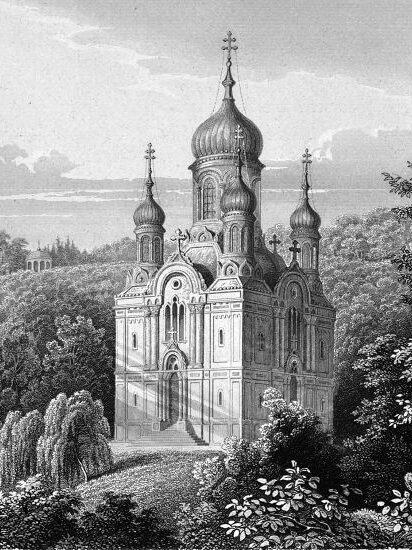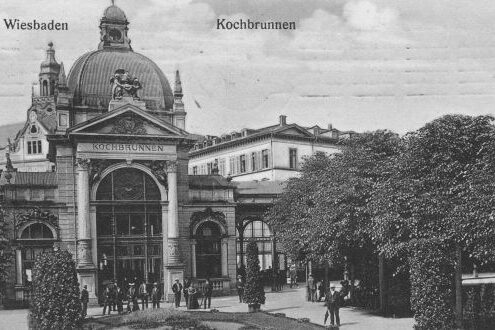Bogler, Wilhelm
Architect, lithographer, draughtsman
Wilhelm Christian Bogler
Born: May 11, 1825 in Wiesbaden
died: April 24, 1906 in Wiesbaden
Wilhelm Bogler, son of Valentin Bogler, principal at the former secondary school on the market, can be traced as an architect in Wiesbaden since his entry in the list of citizens in 1851. His brother was the deputy principal Carl Bogler, his cousin Ida the wife of the painter Kaspar Kögler. Wilhelm Bogler's third marriage was to Kögler's sister Anna Marie.
Bogler worked with Philipp Hoffmann on the construction of the Greek Chapel 1846 - 1855 (Russian Orthodox Church of St. Elisabeth). In 1863, he was instrumental in organizing the Nassau Art and Trade Exhibition. The development plans conceived by Hoffmann and Carl Friedrich Thelemann in 1862/63 for the old, abandoned Schützenhof site and the adjoining Schulberg were implemented by Bogler, in part also as the builder. From 1867 to 1869, the Grand Hotel was built according to his plans (the later Hotel and Bad zum Schützenhof, demolished in 1969), a new post office building opposite in 1869 and a staircase leading to the Schulberg. The houses An der Alten Synagoge 1, 2 and 3, built between 1868 and 1872, were also designed by him. Bogler set up his architectural office in the post office building (Schützenhofstraße 3), while Kögler ran his studio and his painting and drawing school here.
Bogler lived in Adelheidstraße from 1877 onwards, in a house he probably built himself near today's Friedrich Ludwig Jahn School. In 1872, he created the late classicist Villa Beck in Biebrich, which was acquired by the industrialist Ludwig Beck senior in 1898. For the Wiesbaden Casino Society, of which he himself was a member from 1867 to 1892, Bogler designed the building at Friedrichstrasse 22, erected between 1872 and 1874. As an architect of historicism, he drew on the formal repertoire of the Italian Renaissance.
His most important work for Wiesbaden was the Kochbrunnen complex with pavilions and several drinking and promenade halls, built between 1887 and 1890. It gave the old spa center urban weight again. The complex was demolished in the 1960s, with the exception of a promenade hall and the Kochbrunnen spring pavilion. Between 1890 and 1892, St. Joseph's Hospital was built according to Bogler's plans. He also submitted designs and proposals for the new town hall, theater and Kurhaus, which were not commissioned but influenced the discussion.
In 1847, he was a founding member of the Society of Friends of Fine Arts, which later became the Nassau Art Association, and in 1874 of the Middle Rhine Architects' and Engineers' Association. He was also a member of the Association for Nassau Antiquities and Historical Research. Wilhelm Bogler's grave, now abandoned, was located in the old cemetery on Platter Straße. Only a memorial plaque on the casino building still commemorates the renowned Wiesbaden architect.
Literature
- Funk, Birgit
The Wiesbaden architect Wilhelm Bogler, unpublished master's thesis, 2 volumes (text and image section), Frankfurt am Main 1985.
- Funk, Birgit
The work of the Wiesbaden architect Wilhelm Bogler. In: Nassauische Annalen 99, Verein für Nassauische Altertumskunde und Geschichtsforschung (ed.), Wiesbaden 1988 (pp. 111-128).
- Funk, Birgit
The Wiesbaden architect Wilhelm Bogler. In: 175 years of the Wiesbaden Casino Society 1816 - 1991, Wiesbaden 1991 (pp. 139-147).

